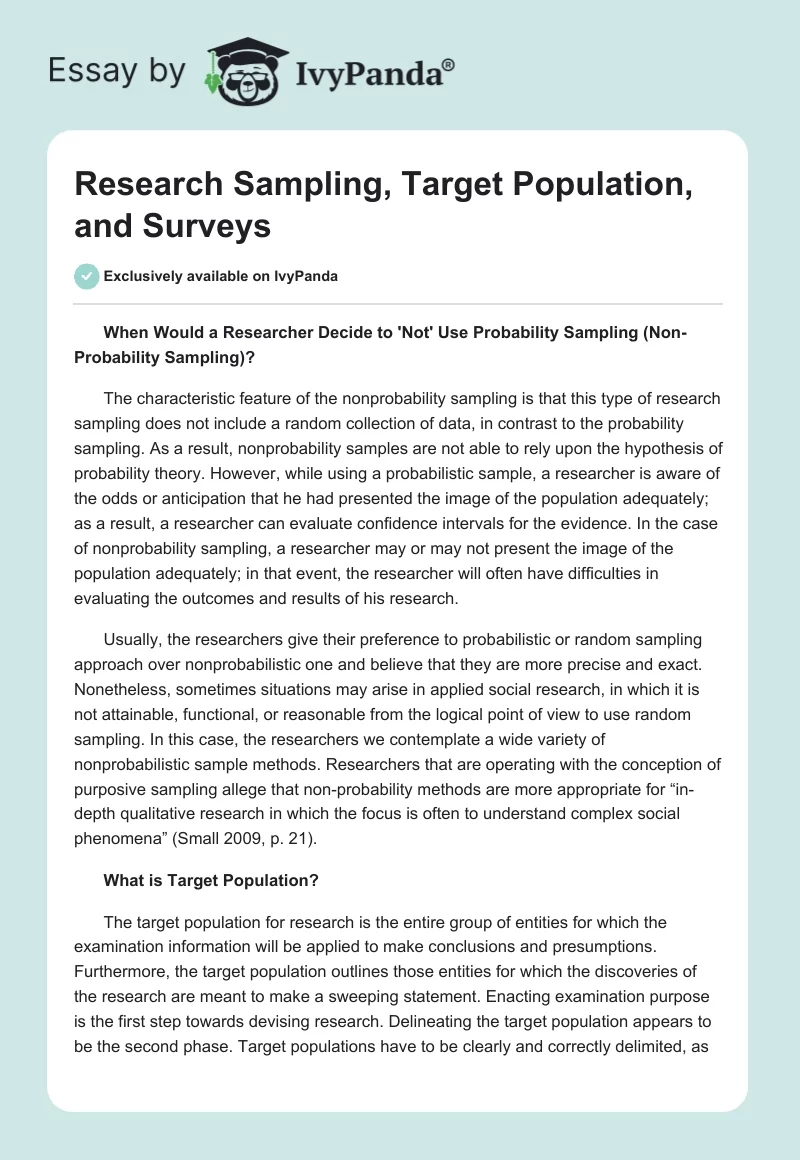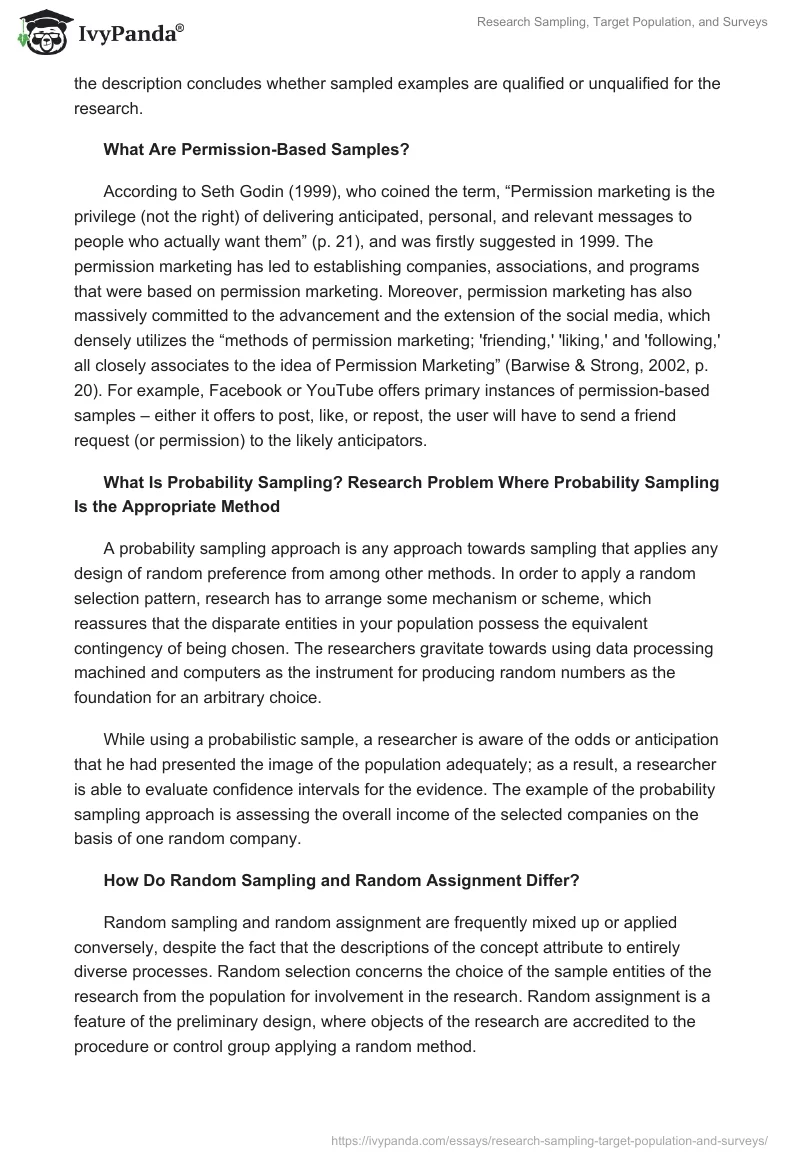When Would a Researcher Decide to ‘Not’ Use Probability Sampling (Non-Probability Sampling)?
The characteristic feature of the nonprobability sampling is that this type of research sampling does not include a random collection of data, in contrast to the probability sampling. As a result, nonprobability samples are not able to rely upon the hypothesis of probability theory. However, while using a probabilistic sample, a researcher is aware of the odds or anticipation that he had presented the image of the population adequately; as a result, a researcher can evaluate confidence intervals for the evidence. In the case of nonprobability sampling, a researcher may or may not present the image of the population adequately; in that event, the researcher will often have difficulties in evaluating the outcomes and results of his research.
Usually, the researchers give their preference to probabilistic or random sampling approach over nonprobabilistic one and believe that they are more precise and exact. Nonetheless, sometimes situations may arise in applied social research, in which it is not attainable, functional, or reasonable from the logical point of view to use random sampling. In this case, the researchers we contemplate a wide variety of nonprobabilistic sample methods. Researchers that are operating with the conception of purposive sampling allege that non-probability methods are more appropriate for “in-depth qualitative research in which the focus is often to understand complex social phenomena” (Small 2009, p. 21).
What is Target Population?
The target population for research is the entire group of entities for which the examination information will be applied to make conclusions and presumptions. Furthermore, the target population outlines those entities for which the discoveries of the research are meant to make a sweeping statement. Enacting examination purpose is the first step towards devising research. Delineating the target population appears to be the second phase. Target populations have to be clearly and correctly delimited, as the description concludes whether sampled examples are qualified or unqualified for the research.
What Are Permission-Based Samples?
According to Seth Godin (1999), who coined the term, “Permission marketing is the privilege (not the right) of delivering anticipated, personal, and relevant messages to people who actually want them” (p. 21), and was firstly suggested in 1999. The permission marketing has led to establishing companies, associations, and programs that were based on permission marketing. Moreover, permission marketing has also massively committed to the advancement and the extension of the social media, which densely utilizes the “methods of permission marketing; ‘friending,’ ‘liking,’ and ‘following,’ all closely associates to the idea of Permission Marketing” (Barwise & Strong, 2002, p. 20). For example, Facebook or YouTube offers primary instances of permission-based samples – either it offers to post, like, or repost, the user will have to send a friend request (or permission) to the likely anticipators.
What Is Probability Sampling? Research Problem Where Probability Sampling Is the Appropriate Method
A probability sampling approach is any approach towards sampling that applies any design of random preference from among other methods. In order to apply a random selection pattern, research has to arrange some mechanism or scheme, which reassures that the disparate entities in your population possess the equivalent contingency of being chosen. The researchers gravitate towards using data processing machined and computers as the instrument for producing random numbers as the foundation for an arbitrary choice.
While using a probabilistic sample, a researcher is aware of the odds or anticipation that he had presented the image of the population adequately; as a result, a researcher is able to evaluate confidence intervals for the evidence. The example of the probability sampling approach is assessing the overall income of the selected companies on the basis of one random company.
How Do Random Sampling and Random Assignment Differ?
Random sampling and random assignment are frequently mixed up or applied conversely, despite the fact that the descriptions of the concept attribute to entirely diverse processes. Random selection concerns the choice of the sample entities of the research from the population for involvement in the research. Random assignment is a feature of the preliminary design, where objects of the research are accredited to the procedure or control group applying a random method.
In What Research Situations Would Random Assignment Be Important?
Random assignment appears in reflecting the selection of entities for the research. In a proper examination, every participant of the research is accredited in a random way to either receiving the treatment or acting as supervision in the research. Despite the fact that random assignment is an uncomplicated process, it could be questionable to enforce away from regulated laboratory conditions. The researchers depend on random assignment in cases where they need to designate subjects to diverse categories in an examination. Randomly assigning subjects provide assistance in eliminating confusing and startling variables; moreover, it is able to differentiate the independent variables that could generate an adjustment in the dependent variable (Bowling, 2005).
What Are the Advantages and Disadvantages of Various Survey Administration Types, Such as Phone, the Web, Telephone, Mail, and Face-To-Face?
Various survey administration types, such as phone, the web, telephone, mail, and face-to-face, have various primary advantages. These methods are distinctly composed, responsive, and resilient. They are founded on private communication and could be contained within the research and environment. “Physical stimuli can be used, and there is the capability to observe the respondents. On the other hand, there are also some disadvantages, such as interviewer bias, high cost per respondent, geographical limitations, and time pressure on the respondents” (Alreck & Settle, 2004, p. 71).
What Are Some Potential Biases That May Be Introduced Based on the Administration Type?
In order to obtain the most exact and factual information from the entities of the research, the researchers have to comprehend and be able to avert or at least decrease the potential biases in the design of their survey administration types (Holbrook, Geen, & Krosnick, 2003). The potential biases are problems with wording, intrusiveness, leading questions; inconsistency; missing or inadequate data for intended purpose; faulty scale, etc. (Bernard, 2005).
What Are the Inherent Problems of Sampling?
The primary inherent problem of sampling is the legitimacy and accuracy of its outcomes. The resolution is situated in the three divisions of regulating a survey: “planning, data collection, and analysis and reporting” (Prierto-Taboada, 2014, p. 521). For the most part, the reporting division of regulating the survey is presented to the general public.
What Techniques Might a Researcher Use to Obtain Higher Returns of Surveys? Provide Published Examples of at Least Two Techniques
The researchers are able to implement cross-sectional and longitudinal surveys in order to achieve higher returns. The published examples of these techniques are ‘A survey of population analysis methods and software for complex pharmacokinetic and pharmacodynamic models with examples’ by R. Bauer and ‘C n.m.r. Spectra of steroids — a survey and commentary’ by J. Blunt.
References
Alreck, P., & Settle, R. (2004). Survey Research Handbook. New York, New York: McGraw Hill.
Barwise, P., & Strong, C. (2002). Permission-based mobile advertising. Journal of Interactive Marketing, 16(1), 14-24.
Bernard, C. (2005). A catalog of biases in questionnaires. Centres for Disease Control and Prevention, 2(1), 13-21.
Bowling, A. (2005). Mode of questionnaire administration can have serious effects on data quality. Journal of Public Health, 27(3), 281-291.
Godin, S. (1999). Permission marketing. New York, New York: Simon & Schuster.
Holbrook, A. L., Geen, M. C., & Krosnick, J. A. (2003). Telephone versus face-to-face interviewing of national probability samples with long questionnaires: Comparison of respondent satisficing and social desirability response bias. Public Opinion Quarterly, 67(1), 79–125.
Prierto-Taboada, N. (2014). The problem of sampling on built heritage: A preliminary study of a new non-invasive method. Environmental Science and Pollution Research, 21(21), 518-529.
Small, M. (2009). How many cases do I need? On science and the logic of case selection in field-based research. Ethnography, 10(1), 5–38.


